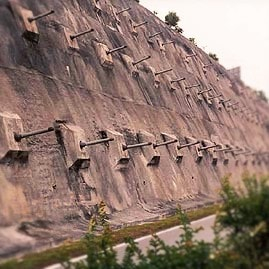Proper installation of ground anchor bolts is essential to ensure structural stability and safety. However, mistakes during the installation process can compromise the performance of these critical components, leading to premature failure or costly repairs. For consumers and professionals alike, understanding common errors and how to avoid them is vital for achieving long-lasting, reliable anchoring solutions.
Understanding the Importance of Correct Ground Anchor Bolts Installation
Before diving into common mistakes, it’s important to recognize the role that ground anchor bolts play in construction and engineering projects. These bolts serve as the fundamental link between a structure and its foundation, bearing loads and resisting forces such as tension, shear, and vibration. Any flaw in their installation can jeopardize the entire structure’s integrity.
Ground anchor bolts are used across various applications, from securing industrial equipment to stabilizing residential structures. Due to their critical function, ensuring precise and professional installation is non-negotiable.
Common Mistakes When Installing Ground Anchor Bolts
1. Inadequate Site Preparation
One of the most frequent mistakes in installing ground anchor bolts is insufficient site preparation. This includes:
-
Ignoring Soil Conditions: Failing to assess soil type, moisture content, and stability can lead to poor bolt performance or shifting foundations.
-
Improper Excavation: Uneven or shallow excavation can prevent bolts from achieving the necessary embedment depth.
-
Lack of Foundation Inspection: Overlooking cracks or weaknesses in the concrete foundation may result in compromised anchoring.
Proper site evaluation and preparation set the foundation for successful bolt installation.
2. Incorrect Bolt Selection
Choosing inappropriate ground anchor bolts is another critical error. Factors to consider include:
-
Material Suitability: Using low-grade steel in corrosive environments can accelerate rust and degradation.
-
Size and Length Mismatch: Bolts that are too short or thin may not withstand the required loads.
-
Type of Anchor Bolt: Selecting between L-shaped, straight, or helical bolts without matching project specifications leads to ineffective anchoring.
Consumers should consult product specifications and, when necessary, seek expert advice to ensure the correct bolt type and grade are used.
3. Poor Installation Techniques
Even with the right bolts and site conditions, improper installation can undermine performance. Common pitfalls include:
-
Misalignment: Bolts not installed vertically or in the exact planned locations cause structural misfits.
-
Inadequate Embedment Depth: Shallow installation reduces the bolt’s capacity to bear loads and resist forces.
-
Insufficient Tightening: Over-tightening risks thread damage, while under-tightening may cause loose fittings.
Attention to detail during installation is essential to maintain bolt effectiveness.
4. Neglecting Corrosion Protection
Corrosion can drastically shorten the lifespan of ground anchor bolts. Neglecting protective measures such as:
-
Using Non-Galvanized Bolts in Moist Environments: Leads to rapid rusting and weakening.
-
Skipping Protective Coatings or Sealants: Exposes bolts to chemical and weather damage.
-
Failure to Inspect Regularly: Misses early signs of corrosion that require maintenance.
Proper corrosion prevention and periodic inspection ensure longevity.
5. Overlooking Manufacturer Guidelines
Ignoring or misunderstanding manufacturer installation instructions often leads to errors such as:
-
Using wrong torque values when tightening bolts.
-
Not following specified curing times for concrete before applying load.
-
Failing to use recommended adhesives or grout.
Following detailed guidelines preserves product integrity and performance.
How to Avoid These Common Installation Mistakes
Conduct Comprehensive Site Analysis
Before installation, perform thorough assessments of soil characteristics and foundation conditions. This ensures that the selected ground anchor bolts will perform effectively under the project’s unique demands.
Choose Quality Ground Anchor Bolts Suited to Your Environment
Select bolts made from materials and coatings designed for your project’s specific environmental challenges. For outdoor or marine applications, stainless steel or hot-dip galvanized bolts offer superior resistance.
Employ Professional Installation Practices
Ensure installers are trained and equipped to:
-
Maintain precise alignment and correct embedment depth.
-
Apply proper torque during fastening.
-
Use adhesives or grout where specified.
Implement a Corrosion Management Plan
Regular inspection and maintenance, coupled with initial corrosion protection, extend the functional lifespan of ground anchor bolts and safeguard structural stability.
Adhere Strictly to Manufacturer Recommendations
Always consult and comply with installation manuals and product datasheets. When in doubt, seek technical support or professional guidance.
The Long-Term Benefits of Correct Ground Anchor Bolts Installation
Avoiding these common mistakes not only prevents structural issues but also yields tangible benefits:
-
Enhanced Safety: Properly anchored structures resist environmental and operational stresses.
-
Cost Savings: Reduced maintenance and repair expenses over time.
-
Compliance: Meeting safety and building code requirements.
-
Peace of Mind: Confidence that your investment is structurally sound.
Conclusion: Prioritizing Precision and Expertise in Ground Anchor Bolts Installation
The installation of ground anchor bolts is a critical phase that demands meticulous attention and professional knowledge. Recognizing and steering clear of common mistakes helps guarantee that your anchoring system will perform as intended, providing the necessary structural stability and longevity.
Whether you are a homeowner overseeing a small project or a contractor managing a large construction site, investing in proper installation practices and quality materials is essential for success.

